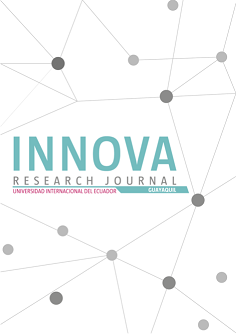Integration of information and communication technologies in university teaching for inclusive education
Main Article Content
Abstract
The article presented aims to analyze how the integration of ICT in the university curriculum favors the generation of learning in diverse social contexts and emerging cognitive processes. The theoretical referents that supported the research were taken from documentary sources that explain the characteristics of the object of study from different theoretical positions, which allowed us to assume a critical stance that teaches the integration and subsequent appropriation of ICT in university teaching with a vision social and inclusive, where the builder emerges that the appropriation is conceived as the full integration of ICT in the cultural and social context of teachers. From the context presented, it is stated that the teacher has the ability to use ICT to the point of making them important for their daily activities in the classroom and thus generate ICT skills that contribute significantly to the improvement of their living conditions and their social transformation (Hill, 2018). Given this context, it is affirmed that the development of educational inclusion requires a relevant analysis of educational practices with their corresponding processes of transformation, not being reduced as a punctual discourse with a limited time course, since there have been many declared intentions and written regulations that have been implemented in multiple contexts for this educational modality. Finally, a systematization and reflections were reached in the definitions of integration and appropriation of technologies to favor educational inclusion, specifying in the university teacher for being an element of vital importance with a view to contributing to the improvement and preparation of autonomous, critical students of knowledge and society by acquiring professional training.
Downloads
Article Details
COPYRIGHT NOTICE
Authors who publish in the INNOVA Research Journal keeps copyright and guarantee the journal the right to be the first publication of the work under the Creative Commons License, Attribution-Non-Commercial 4.0 International (CC BY-NC 4.0). They can be copied, used, disseminated, transmitted and publicly exhibited, provided that: a) the authorship and original source of their publication (magazine, publisher, URL and DOI of the work) is cited; b) are not used for commercial purposes; c) the existence and specifications of this license of use are mentioned.
References
Cabero, J. (2008) TICs para la igualdad: la brecha digital en la discapacidad. Revista ANALES Universidad Metropolitana 15 Vol. 8, Nº 2 (Nueva Serie). Recuperado en: https://www.researchgate.net/publication/233926363_TICs_para_la_igualdad_la_brecha_digital_en_la_discapacidad.
Cabero, y Fernandez (sf.) Una mirada sobre las TIC y la Educación Inclusiva. Reflexión en torno al papel de las TIC en la Educación Inclusiva. Recuperado de: http://www.centrocp.com/una-mirada-sobre-las-tic-y-la-educacion-inclusiva/.
Cardón, D. (2006). La innovación por el uso. En: Ambrosi, A., Peugeot, V. y Pimienta, D. Palabras en juego: enfoques multiculturales sobre las sociedades de la información. C&F Editions. Recuperado de: http://www.casanas.com.ar/artsAdj/Palabras_en_juego-221.pdf.
Claro, M. (2011). El papel de las tecnologías de la información y las comunicaciones en la educación inclusiva. Santiago de Chile: CEPAL. Documento en línea. Disponible: https://repositorio.cepal.org/handle/11362/3937.
Colina, A. (2018). Apropiación De Las TIC. Docencia Universitaria Y Pensamiento Complejo. Universidad Nacional Experimental “Rafael María Baralt”. Tesis Doctoral.
Echeita, G. (2009). “Los dilemas de las diferencias en la educación escolar”. En Verdugo, M.A. et altri. “Mejorando resultados personales para una vida de calidad. VII Jornadas Científicas de Investigación sobre Personas con Discapacidad”. Salamanca: Amarú. pp. 381-395.
García, M., López, R. (2012). Explorando, desde una perspectiva inclusiva, el uso de las TIC para atender a la diversidad. Profesorado Revista de curriculum y formación del profesorado, 16(1), 277-293.
Hernández, P. (2003). Formación Docente en Educación Superior: la experiencia de un modelo de intervención. Artículo en línea. Disponible: http://www.contexto-educativo.com.ar/2003/3/nota-05.htm.
Johnson, C. (1993). Aprendizaje Colaborativo, referencia virtual del Instituto Tecnológico de Monterrey, México Disponible: http://campus.gda.itesm.mx/cite.
Laitón Z,, E., Gómez A., S., Sarmiento P., R., y Mejía C., C. (2017). Competencia de prácticas inclusivas: las TIC y la educación inclusiva en el desarrollo profesional docente. Sophia, 13 (2), 82-95.
Llorente C., M. (2005). Tutoría virtual. Documento en línea. Disponible: http://tecnologiaedu.us.es/cuestionario/bibliovir/tutoriavirtual.pdf.
Martínez, M. (2004). Ciencia y Arte en la metodología cualitativa. México: Trillas.
Mass T., O., Olmos R., P. (2012). La atención a la diversidad en la educación superior: Una perspectiva desde las competencias docentes. Revista Educación Inclusiva Vol. 5, N° 1. Recuperado en: http://www.ujaen.es/revista/rei/linked/documentos/documentos/15-12.pdf.
Morín, E. (1998). Introducción al pensamiento complejo. Editorial Gedisa. España.
Moya, A. (2009). Las nuevas tecnologías en la educación. Revista Digital de Innovación y Experiencias Educativas, (45), 1-9.
Organización de las Naciones Unidas para la Educación, la Ciencia y la Cultura (UNESCO, 2008), en el informe “Los docentes y la enseñanza en un mundo en mutación”.
Suárez, J.M. Almerich, G. Gargallo, B. y Aliaga, F (2010) “Las competencias en TIC del profesorado y su relación con el uso de los recursos tecnológicos” Archivos Analíticos de Políticas Educativas, 18 (10). Disponible: http://epaa.asu.edu/ojs/article/view/755.
Torres, A. (2004). “Necesidad de reforma universitaria y educación abierta y a distancia” Documento en línea. Disponible: http://www.unidad094.upn.mx/revista/39/reforma.htm.
Watts, C. y Lee, L (2017). Las TIC como herramientas de inclusión educativa. Acta Scientiae Informaticae 1 (1), 91-97.






